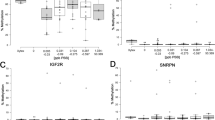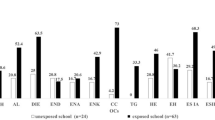Abstract
THE hazard to man of environmental contamination by certain metals is of considerable importance and in this context the organic and inorganic compounds of lead are the subject of much current interest. The clinical effects on the individual of accidental overexposure to lead are well known. What is perhaps not so widely realised, however, is that there is the possibility that high lead levels may be hazardous to the foetus of exposed parents. “Intoxication with lead” is often quoted as “reducing fertility and increasing the frequency of abortions and miscarriages” in man1–5, and some animal studies have shown6 that administration of lead salts may result in an increase in congenitally malformed offspring. These findings, the reported carcinogenicity of lead salts in rats7, and the earlier reports that salts of a variety of heavy metals induce aberrations in plant chromosomes8,9, have stimulated a number of in vitro and in vivo studies into the possible mutagenic effects of lead which have yielded conflicting results.
This is a preview of subscription content, access via your institution
Access options
Subscribe to this journal
Receive 51 print issues and online access
$199.00 per year
only $3.90 per issue
Buy this article
- Purchase on Springer Link
- Instant access to full article PDF
Prices may be subject to local taxes which are calculated during checkout
Similar content being viewed by others
References
Muro, L. A., and Goyer, R. A., Archs Path., 87, 660 (1969).
Weller, C. V., J. med. Res., 33, 271 (1915).
Potter, E. L., in Pathology of the Fetus and Newborn, 168 (Year Book Medical Publishers, Chicago, 1961).
Gillet, J. A., Lancet, i, 1118 (1955).
Nishimura, H., in Chemistry and Prevention of Congenital Abnormalities, 13 (Thomas, Springfield, Illinois, 1964).
Ferm, V. H., and Carpenter, S. J., Expl. molec. Path., 7, 208 (1967).
Hass, G. M., McDonald, J. H., Oyasu, R., Battifora, H. A., and Paloucek, J. T., in Renal Neoplasia (edit. by King, J. S., jun.) (Little, Brown, Boston, 1967).
Glass, E., Zeit Bot., 43, 359 (1955).
Steinman, I. D., Venkatrum, N. I., and Szybalski, W., Archs Biochem. Biophys., 76, 78 (1958).
Schwanitz, G., Lehnert, G., and Gebhart, E., Deut. Med. Wochschr. (English Language Edition), 15, 738 (1970).
Bauchinger, M., and Schmid, E., Mutat. Res., 14, 95 (1972).
Kennedy, G. L., and Arnold, D. W., Newsl. Environ. mutag. Soc., 5, 37 (1971).
Taylor, W., Molyneux, M. K. B., and Blackadder, E. S., Nature, 247, 53 (1974).
Hungerford, D. A., Stain Technol., 40, 333 (1965).
Bauchinger, M., Schmid, E., and Schmidt, D., Mutat. Res., 16, 407 (1972).
Buckton, K. E., and Pike, M. C., Int. J. rad. Biol., 8, 439 (1964).
Sasaki, M. S., and Norman, A., Nature, 210, 913 (1966).
Evans, H. J., in Human Population Cytogenetics (edit. by Jacobs, P. A., Price, W. H., and Law, P.), 191 (Edinburgh University, Edinburgh, 1970).
Buckton, K. E., Smith, P. G., and Court Brown, W. M., in Human Radiation Cytogenetics (edit. by Evans, H. J., Court Brown, W. M., and McLean, A. S.), 106 (North-Holland, Amsterdam, 1967).
Report of United Nations Scientific Committee on the Effects of Atomic Radiation, UN General Assembly 24th Session Supplement 13 (A/7613) (1969).
Author information
Authors and Affiliations
Rights and permissions
About this article
Cite this article
O'RIORDAN, M., EVANS, H. Absence of Significant Chromosome Damage in Males Occupationally Exposed to Lead. Nature 247, 50–53 (1974). https://doi.org/10.1038/247050a0
Received:
Revised:
Issue Date:
DOI: https://doi.org/10.1038/247050a0
This article is cited by
-
Elevated blood lead levels and cytogenetic markers in buccal epithelial cells of painters in India
Environmental Science and Pollution Research (2010)
-
Absence of an effect of lead acetate on sperm morphology, sister chromatid exchanges or on micronuclei formation in rabbits
Archives of Toxicology (1982)
-
Cytogenetic investigations in volunteers ingesting inorganic lead
International Archives of Occupational and Environmental Health (1976)
-
The human leukocyte test system
Human Genetics (1975)
-
Lead Over-absorption in a Population of Oxy-gas Burners
Nature (1974)
Comments
By submitting a comment you agree to abide by our Terms and Community Guidelines. If you find something abusive or that does not comply with our terms or guidelines please flag it as inappropriate.



